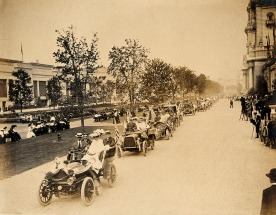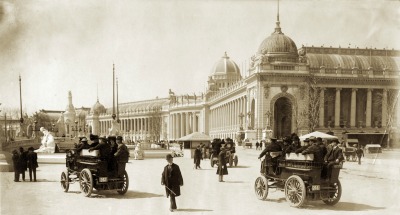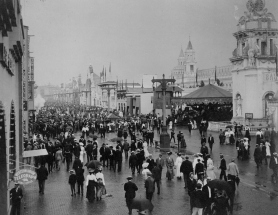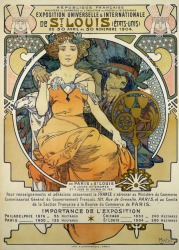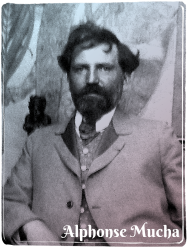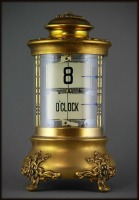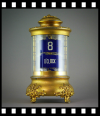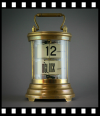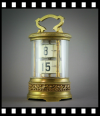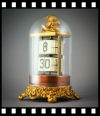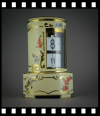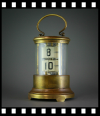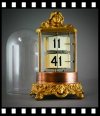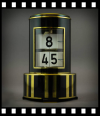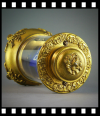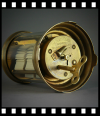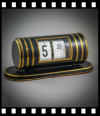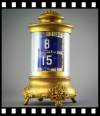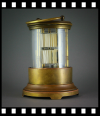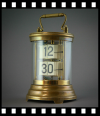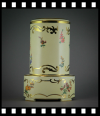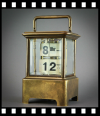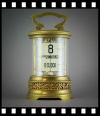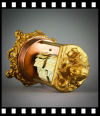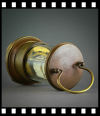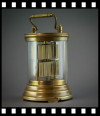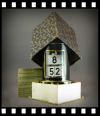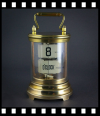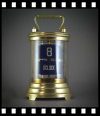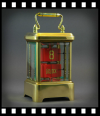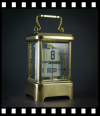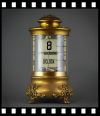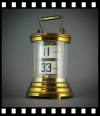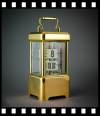
The Plato Clock represents one of the earliest digital displays of time and holds a prominent place in the history of flip clocks.
In recent years, prices for Plato Clocks (also known as Plato Flip Clocks) have soared. Selling prices from $600 dollars up to $1000 dollars or more have been noted on online auctions. In this climate, it would definitely be wise for the collector to have a grasp on the different varieties of Plato Clocks. Also, it would seem beneficial for sellers to have some firm factual information regarding a particular Plato Clock that they are selling. We will cover these issues in detail, and at the end, try to put the Plato Clock in perspective in regards to its actual place in clock history.
Piecing together the confusing and at times contradictory information regarding Plato Clocks can be difficult for buyer and seller and collector of these clocks. To achieve a solid and useful understanding of the Plato Clock, we should come to learn and appreciate the influence in this area of one particular person - collector, inventor, businessman, marketing expert, author, clock buyer, seller and repairer, Charles O. Terwilliger.
Charles Ostrander Terwilliger Jr. was born in Pawtucket, Rhode Island, March 22, 1908[1] and died on February 17, 1988 in Bronxville, New York at age 79.[2] His main source of income came from employment at MacFadden Publications in Manhattan, New York in the field of magazine advertising, working in the areas of sales, promotion and market research.[3]
 With horology starting first as a hobby, but eventually becoming his life's work,[3]Charles Terwilliger established the The Horolovar Company in 1951, which became the trusted source for suspension springs and other parts for anniversary clocks (also known as 400-Day Clocks).[4]
With horology starting first as a hobby, but eventually becoming his life's work,[3]Charles Terwilliger established the The Horolovar Company in 1951, which became the trusted source for suspension springs and other parts for anniversary clocks (also known as 400-Day Clocks).[4]
Terwilliger essentially revolutionized the repair and maintenance the 400-Day Clock by the development of an improved suspension spring for these clocks, which came to be known as the "Horolovar Temperature Compensating Suspension Spring." Terwilliger also authored the definitive guide to the clock's repair - the "Horolovar 400-Day Clock Repair Guide."[3]First published in 1953, the guide remains a widely known and respected resource in horological circles, and today can be found in its 10th Edition.[5] The Horolovar Company, which to this day remains the leader in providing suspension springs for the 400-Day Clocks, moved to Lancaster, Ohio after being acquired in 2009 by Chris Nimon.[6]
Charles O Terwilliger, Jr was a member of the National Association of Watch and Clock Collectors (NAWCC) from 1950 until his passing in 1988. Over his 38 years with the NAWCC, he serve in many roles, including multiple stints as Director and as the head of numerous committees, and serving as a member of the editorial board of the NAWCC Bulletin.[2] In this capacity, he wrote numerous Bulletin Articles, including the one published in October 1964 and most often used as the source when referring to the Plato Clock: "Eugine L. Fitch and the Plato Clock."[7] This particular article can be found in pdf format on the web.[8] However, less widely available is the June 1970 revised and reprinted version that added important new information about the later reproduction Plato clocks.[9]
It is from these articles that we learn that no later than 1964, Terwilliger, through the Horolovar company, became the exclusive distributor of reproduction Plato Clocks made by Josef Mergenhagen of Germany. This included a traditional vertical model as well as a horizontal model styled after an earlier Eugene Fitch patent.[7] J. Mergenhagen's buisness was absorbed by Karl Lauffer Uhrenfabrik at Schwenningen, Germany in 1965.[9] It was under this company that the Plato Clock line was expanded to include many ornate plato-type clocks, again, only available in the US through Terwilliger's Horolovar company.[9][10] Later in this article, we will go into more detail about these and other Plato clock varieties. But this is noted here to establish Terwilliger's major role in Plato Clock collecting.
 Charles Terwilliger's influence over collecting of the Plato Clock does not end at the import of the German made, more modern Plato Clocks. Under the name of the Horolovar Company, Terwilliger contracted to have five historically significant and curious clocks reproduced for sale,[3] including a Plato Clock which he contracted to have made by Karl Lauffer of Germany. This reproduction would eventually be known by collectors as the "Horolovar Plato Clock." With this upgraded reproduction, Terwilliger sought to produce an authentic recreation of the look of the original, first design of the Plato Clock, with a better mechanism, in contrast to the more ornate German clocks that he already distributed. With his background in marketing, it seems likely that Mr Terwilliger figured that a clock bearing the Horolovar name would help advance the company's name recognition and reach - assuming that the clock became popular.
Charles Terwilliger's influence over collecting of the Plato Clock does not end at the import of the German made, more modern Plato Clocks. Under the name of the Horolovar Company, Terwilliger contracted to have five historically significant and curious clocks reproduced for sale,[3] including a Plato Clock which he contracted to have made by Karl Lauffer of Germany. This reproduction would eventually be known by collectors as the "Horolovar Plato Clock." With this upgraded reproduction, Terwilliger sought to produce an authentic recreation of the look of the original, first design of the Plato Clock, with a better mechanism, in contrast to the more ornate German clocks that he already distributed. With his background in marketing, it seems likely that Mr Terwilliger figured that a clock bearing the Horolovar name would help advance the company's name recognition and reach - assuming that the clock became popular.
It seems historically relevant that a newspaper article from January 1967 reported that an original Plato Clock belonging to James Niehaus of Dayton, Ohio (president of the Buckeye Chapter 23 of the NAWCC) was selected by "a New York manufacturer" as the model for reproduction.[11] This was certainly a misunderstanding by the reporter, since stamping on the bottom of the 7 jewel, 8-day movement clock reveals that the reproduction Plato Clock was manufactured in "West Germany" for "The Horolovar Company, Bronxville, New York."[11]
Unfortunately, the Horolovar Plato Clock, like it's predecessor, the original Plato Clock, did not go big, and production of the Horolovar Plato Clock ran only from 1969[9] to 1971.[12]
In spite of this, no one person has influenced collection of all versions of the Plato Clock like Charles Terwilliger personally, and through his Horolovar Company. His NAWCC Bulletin articles remain the only authoritative sources regarding these clocks. And nearly every description of the Plato clock in collector circles, online auctions and online sources (not to mention the the bulk of the historical aspects discussed here) includes information that can be traced directly back to these articles.
Now that the stage is set, it is proper time to discuss in more detail, the Plato Flip Clock - the first true flip clock and known by many as "the Grandfather of all Flip Clocks."
The Plato Flip Clock
The history of the Plato Clock holds great importance for those interested in the digital display of time including fans of flip clocks. But we will discover that with the passage of time, history becomes more than a little warped, even morphing at times into outright untruths. This defines the primary purpose of this discussion. Here we will to try to set the conversation of the history of these clocks back on track, moving at least as close to the truth as possible. To begin, lets start with the name of the clock and the wide-spread misinformation about it's origin.
What's in a Name?
 With collecting and studying clocks it's a small step to wax philosophical. Consider a clock - it's a tool to measure and communicate the passage of time to people who are themselves inescapably, day by day, second by second, moving towards their eventual mortal end. Clock collecting, in a way, could be described as the attempt to literally get a hold on time, to possess or control time. But in reality, time slips through our fingers like sand, we cannot hold on to it, or stop it, or reverse it (in spite of what the proponents of Daylight Saving Time seem to think).
With collecting and studying clocks it's a small step to wax philosophical. Consider a clock - it's a tool to measure and communicate the passage of time to people who are themselves inescapably, day by day, second by second, moving towards their eventual mortal end. Clock collecting, in a way, could be described as the attempt to literally get a hold on time, to possess or control time. But in reality, time slips through our fingers like sand, we cannot hold on to it, or stop it, or reverse it (in spite of what the proponents of Daylight Saving Time seem to think).
So, was it a philosophical mindset that was behind the naming of the Eugene Fitch clock "Plato Clock" after the famous Greek philosopher, Plato? Absolutely not! The new clock needed a suitable and catchy name before it went to market, and the lawyer that Eugene Fitch consulted for his patents, Henry D. Williams, suggested the name "Plat-O" as a nod to the flipping plates that displayed the time. According to Williams (in a letter written in 1942 to an editor of the journal "American Holologist and Jeweler") from the very beginning the public mistakenly deduced that "Plato" referred to the Greek philosopher.[9]
As recently as 1998, a widely distributed syndicated newspaper article by Ralph and Terry Kovel[13] asserted that: "In 1902, a novelty clock was patented that resembled a lantern. Flipping numbered cards displayed the time. The clock had a brass stand and handle with a glass cylinder enclosing the cards. The unusual clock was named the "Plato" because the famous Greek philosopher Plato was said to have carried a lantern shaped like the clock while he was "looking for an honest man."
This article is full of errors. Firstly, what they call the "lantern shaped clock" was not modeled after a lantern, but after late 19th century carriage clocks (we will talk more about this later). Also, this first true Plato Clock was patented July 7, 1903,[14]not 1902. But the authors of this article were close. It was the boxy, horizontally flipping model that received patent No. 715,776 on December 16, 1902.[15] And it was a stepping stone to the Plato Clock. But this was not the final, supposedly "lantern" shaped version. But secondly, and more importantly, the clock, absolutely and without question, was not named after Plato. For one thing, Plato was never said to have been holding a lantern "looking for an honest man." That was the Greek Cynic philosopher, Diogenes of Sinope.[16]
 Although he was a contemporary of Plato, Diogenes, may have been thought by Plato to be a madman. Diogenes chose to live out of a huge jar or barrel and had nothing good to say about societal norms or etiquette. Regarding his philosophy, in a nutshell, he apparently believed that society could never be the source of virtue since manners and society in general were based on lies, since people often said or did things in private that they would never do in public (he would have loved social media). Evidently for this reason, perhaps to make a point, he would urinate and pleasure himself in public when the urge came over him, so that he would be more genuine, I suppose. The myth is that he carried a lantern about Athens, Greece, holding it up to peoples' faces, looking for an honest man - apparently, finding none. The bottom line is this: it was Diogenes of Sinope who carried a lantern looking for an honest man, not Plato. Not only this, Plato would probably be appalled that a myth surrounding Diogenes, was being attributed to him. In summary, and to make it perfectly clear: The Plato Clock was not named after Plato.
Although he was a contemporary of Plato, Diogenes, may have been thought by Plato to be a madman. Diogenes chose to live out of a huge jar or barrel and had nothing good to say about societal norms or etiquette. Regarding his philosophy, in a nutshell, he apparently believed that society could never be the source of virtue since manners and society in general were based on lies, since people often said or did things in private that they would never do in public (he would have loved social media). Evidently for this reason, perhaps to make a point, he would urinate and pleasure himself in public when the urge came over him, so that he would be more genuine, I suppose. The myth is that he carried a lantern about Athens, Greece, holding it up to peoples' faces, looking for an honest man - apparently, finding none. The bottom line is this: it was Diogenes of Sinope who carried a lantern looking for an honest man, not Plato. Not only this, Plato would probably be appalled that a myth surrounding Diogenes, was being attributed to him. In summary, and to make it perfectly clear: The Plato Clock was not named after Plato.
Correcting this historical naming error clearly was also very important to Charles Terwilliger, who took pains to set the record straight. Terwilliger wrote about the naming confusion in both versions of his articles about the Plato clock and also included the correction of fact on at at least two different advertising pieces - one describing the Horolovar reproduction clock and another detailing the models of the German reproductions that he distributed.[7][9][10][17]
The numerous variations of the Plato Clock and more details
It is my opinion that any Plato clock possesses value, not only as a collectible, but also as a historical piece relating to the history of digital time, which includes flip clocks, regardless of the time period of manufacture or country of origin. Even the latest reproduction, the circa 1970 Horolovar Plato clock, is as old or older than many collectible vintage flip clocks, and has an important place in flip clock history.
So to get a more complete understanding and appreciation of the Plato Clocks we will explore eight important areas:
1) a basic history of the original Plato Clocks
2) the styles of the original four versions of the clock
3) the French and German (pre-world war one) clocks
4) the British Clocks including high grade sterling sliver clocks
5) the later (around 1960s) German made reproduction clocks
6) the 1970s Horolovar model
7) The artistic style of the Platos
8) The brutal truth regarding the true quality of the original Plato clocks and their place in horology.
Plato Clock History
The Plato Clock made it's appearance on the world stage at the famed 1904 St Louis World's Fair, as a part of an exhibit by the American Electrical Novelty and Manufacturing Company (which would later become the EverReady Battery Company).[18][19] Photographs from the 1904 World's Fair, the largest in history up to that time, provide a glimpse into the time period of the original Plato Clocks. The cars, the architecture, the clothing fashion, puts into perspective the people that the clocks were being marketed to.
A French advertising poster for the 1904 World's Fair, by artist Alphonse Mucha holds some interest regarding this time period. Later in this discussion, we will use this artist's work to describe the artistic style of some of the early Plato Clocks.
The inventor of the Plato Clock was Eugene L. Fitch of New York City. Fitch received patent number 733,180 on July 7th 1903[14] for the clock that would become the basis of all subsequent models and styles of Plato Clocks. However, he did receive other patents as early as Dec 16, 1902[15] related to the clock, which probably explains some sources claiming that clock was invented in 1902. Interestingly, the first patent of 1902 looks more like our modern flip clocks. So as you can see, Eugene Fitch could be said to be the inventor of flip clocks in general, not just the Plato Clock.
The man who took an interest in Fitch's invention and who is credited with actually getting these clocks produced, was Conrad Hubert, owner of the American Electrical Novelty and Manufacturing Company. Mr Hubert contracted with the Ansonia Clock Company to manufacture the clocks and marketed the clocks under the name "The Famous Ever Ready Plato Clock."
Therefore a proper summary statement of the original clock's history, in my opinion, should read something to the effect:
The Plato clock displays the time by what the inventor and distributor called numbered, "plates" that were originally made of celluloid (which is considered to be the first thermoplastic, in common use by 1870). The hours digits appeared stacked above the minutes with the plates flipping like pages of a book to reveal the advancing time. All versions were either stamped or cast brass with glass protecting the plates. American made Plato clocks came in four designs and could be had with either red, white or blue number plates - the colored plates bearing white numbers and the white plates displaying black numbers.[20] The four designs in some literature are numbered as follows:
Design 1 - The classic cylindrical style with a sleeve of glass, with handle on top.
Design 2 - The figurine topped clock, covered by a dome of glass.
Design 3 - Rectangle shaped clock with 4 separate pieces of glass, topped with a handle.
Degign 4 - A button topped (or what some collectors call a mushroom topped) ornate version with a glass sleeve.
You will often read that the production number of these clocks was 40,000. However, this is pure speculation. This number was suggested as an estimate by Eugene Fitch's patent attorney, Henry D Williams in 1942[9], many years after the production and selling of these clocks. The fact is, no hard production records exist and we have to take this as an educated guess, remembering that Williams was not actually involved in the production of the clocks.
Charles O. Terwillier (who we previously introduced), in his work "Eugene L Fitch and the Plato Clock"[9] asserted that the original clocks have many variations due to the following variable characteristics:
- the bottom of the movement plate may or may not have the marking "Ansonia Clock Co."
- the clock may have an attached winding key, or a separate key that attaches to the squared winding arbor.
- those clocks with a separate key may or may not have a clamp on the bottom of the cover plate to hold the key.
- the cover of the movement on the bottom of the clock may or may not display the patent dates and the words "The Plato Clock."
- the font used for the numbers comes in a few different styles.
- the numerals will be either white on blue, white on red or black on white.
- the metal pieces that holds the number plates back may be piano wire or more often blued steel.
- design number 2 (the one with the figure on top) comes in a smaller version but probably produced in small numbers, since the plates did not have much clearance.
- design number 4 (the mushroom top) may have a five-pointed star with the number 60 in the center - significance unknown.
- there is a design number 1 (the cylindrical version clock) that does not have tabs on the numeral plates 56-59 as is the norm, but instead uses a brass cam to move the metal hook up to hold the hour until the minutes pass 59. Terwilliger speculates that this may be one of the earliest models.
The Early French and German Plato Clocks
It is known that three different German clock makers and probably two different French manufactures produced Plato Clocks prior to World War I - that is, prior to 1914. During this time an unknown French company produced what they called the "Fitch Clock" which looked nearly identical to the first design of the Plato Clock (that is the cylindrical design number 1). Recently a superbly designed French clock, more ornate than the original, appeared on eBay and sold for nearly a thousand dollars. The bottom of the clock had a marking that included the words "Fitch Clock."
The three German manufactures were The Hamburg-American Clock Company (whose trade mark consisted of crossed arrows. The word "American" does not indicate an association with the United States, but is a designation of a type of clock movement that the company featured in other clocks), Lenzkirch Uhrenfabrik (Uhrenfabrik means clock or watch factory in German) and Gebrüder Junghans (in English the Junghans brothers). The Junghans Plato Clocks could be found in both brass and nickle plated brass cases. Most or all of the Junghans clocks includes a trademark/logo stamped on the top that reads "Ever Ready Chronos Clock."
The Later German Made Platos
In 1953 Uhrenfabrik Laufamholz Köhler & Co. produced a Plato Clock with some significant different styling that the original Plato clocks. Some of these exhibited more ornate, painted cases with floral designs. These clocks can be identified by the markings "Köhler" or "Abessi." Abessi was a brand name used by Armbruster & Böhringer GmbH. in Pforzheim, Germany[21], who were the makers of the cases. Uhrenfabrik Laufamholz Köhler & Co sold the tools and rights to produce these clocks to an employee, Josef Mergenhagen, who improved the clock by adding non-warping plastic plates for the numerals. Clocks made by this maker may include the stamping "J. Mergenhagen" on the bottom. In 1965 Mergenhagen's business was absorbed by Karl Lauffer Uhrenfabrik GmbH, Schwenningen, Germany, who continued to make the Plato type clocks until around 1970 it is supposed. These German clocks were distributed in the United States exclusively by the Horolovar Company, Bronxville, New York under the ownership of Charles Terwilliger.[22] This is the same Karl Lauffer Company that accepted the contract to make the Horolovar Reproduction Plato Clock.
The Last Plato Clock
In 1969 Charles O. Terwilliger, as head of the Horolovar company, brought the Plato Clock history full circle, by producing a reproduction of the original, cylindrical brass and glass clock with the handled top, also known as Design 1. Terwilliger, in promotional material, described this clock as "so close to the original in outward appearance that only an expert can tell them apart" but adding that unlike the original one day clock, the Horolovar clock had a "7-jewel, 8-day movement."[10] As mentioned, the clock was manufactured by Karl Lauffer Uhrenfabrik GmbH, Schwenningen, Germany and sold under the name Horolovar. The bottom plate of these clocks reads "West Germany, Seven (7) Jewels unadjusted, The Horolovar Company, Bronxville, New York." The production of the clock ended in 1971. Collectors refer to these clocks as "the Hololovar Plato Clock."
The Plato Clock - Artistic style and Place in Horology
It is my opinion that the original Plato clocks are of two distinct styles. The original cylindrical clock and the rectangular shaped clock, both of which have handles on top, are styled after mid to late 19th century carriage clocks in the corniche and oval styles. These carriage clock styles were very prevalent at the time of the initial production of the Plato Clocks.[3]
Now concerning the other two styles (the ones with the figurine and the button on top) - this pair could probably be best described as having the style that chronologically preceded Art Deco, namely, Art Nouveau.
 Art Nouveau[23][24]] is a style of art, architecture and applied art, highly popular between 1890 and 1910, often described as an ornamental art form, Art Nouveau is defined by asymmetrical, long, organic, natural lines. These usually long, undulating lines are often represented by natural objects such as vines, stalks and flowers. In discussions of Art Nouveau you will nearly always hear mention of the whiplash line. These lines rhythmically bend back on themselves, seeming to hold a force about to be released, like a whip. In addition, in many Art Nouveau popular art works and posters, it seems to me that there nearly always exists one main subject, very often a woman's upper torso and face, or her full form with its naturally flowing curves, with a very ornamental, somewhat flat background of repeating patterns and flowing lines. The colors used in Art Nouveau frequently seem muted and often pastel-like.
Art Nouveau[23][24]] is a style of art, architecture and applied art, highly popular between 1890 and 1910, often described as an ornamental art form, Art Nouveau is defined by asymmetrical, long, organic, natural lines. These usually long, undulating lines are often represented by natural objects such as vines, stalks and flowers. In discussions of Art Nouveau you will nearly always hear mention of the whiplash line. These lines rhythmically bend back on themselves, seeming to hold a force about to be released, like a whip. In addition, in many Art Nouveau popular art works and posters, it seems to me that there nearly always exists one main subject, very often a woman's upper torso and face, or her full form with its naturally flowing curves, with a very ornamental, somewhat flat background of repeating patterns and flowing lines. The colors used in Art Nouveau frequently seem muted and often pastel-like.
Art Nouveau came on the scene just as lithography printing became an economical reproduction method. This resulted in an explosion of posters for use in advertising as well as an increased availability of art for the general public. Perhaps the use of beautiful women in advertising had it's start during this period as you can see all types of products advertised in this style featuring women.
Of particular interest for our discussion is the work of Alphonse Mucha[25], a Czech artist living in Paris during the Art Nouveau period. As previously mentioned, Mucha painted the French Poster for the 1904 World's Fair where the Plato Clock was reportedly unveiled. But Mucha is best known for his distinctive, decorative, theatrical advertising posters of Sarah Bernhardt. This becomes very important for us as you will soon see. Sarah Bernhart was an internationally known French stage actress, very active in the time period of the Plato clocks - the late 19th and early 20th centuries. Bernhardt commissioned Mucha to produce many posters for her theater performances featuring herself. These have come to be well recognized works of art of the Art Nouveau style, and are highly prized in many art circles.
So what do Mucha and Bernhardt have to do with Plato Clocks. Now that we have a basic understanding of the Art Nouveau style, we can see that the two original Plato Clocks without handles have elements, clearly of the Art Nouveau style. While some describe the figure on the top of the domed Plato Clock as an "angel" or simply "a figurine," we must now conclude that it is simply a depiction of a woman with long flowing hair. There are no angel wings here, but there are flowers and flowing lines. I have no proof of this, and have not read it anywhere else, but I'd like to made the bold assertion, that the figure on top of the Plato clock, is actually a facsimile of, you may have guessed it, Sarah Bernhardt. Obviously no one would make that statement during their marketing, when Bernhart was active. Yet most people would be familiar with the style and the subject. Yes, I believe that this clock could be described as being adorned with an Art Nouveau inspired figure of a woman, highly suggestive of Sarah Bernhardt.
While the Plato Clocks are frequently described in glowing terms on auction sites, it seems important to accept that the clocks were not of the highest grade and quality, since they were actually intended to be mass produced and marketed to the general public. The Art Nouveau styling is there, but it's not high art. And the quality of all the early Plato clocks could be considered good, but it was not considered to be of the highest quality. This can be seen when you consider the quality of fine carriage clocks from the same period. In the book "A Century of Fine Carriage Clocks" by Joseph Faneli and edited by our very own, Charles Terwilliger,[3] we can see the high level of artisanship in the clocks of this same period. The Plato Clocks do not even approach the artistic quality, manufacturing standards or high grade of inner clock works of the fine carriage clocks of the 19th and early 20th centuries. This should not be taken as insult to these historical clocks and those that collect them. It's just a matter of horological fact.
Even Charles Terwilliger, clearly a fan of the Plato Clock, admitted as much, decribing his Horolovar reproduction as having an upgraded movement giving it "timekeeping qualities never dreamed of in the original model."
How are Plato Clocks viewed by Traditional Horologists
 The NAWCC established the world renound National Watch & Clock Museum - now the "largest and most comprehensive horological collection in North America" with well over 12,000 items.[26] You might expect there to be a complete section detailing the history and importance of the Plato Clocks. Unfortunately for flip clock fans, you'd be very disappointed. If you look hard enough, you'll find an example of the rectangular Plato clock. But the clock is mixed in among various "Novelty Clocks." In fact, this original Plato clock rests next to a clock with a doll swinging from a tree branch, sitting on a shelf above some Lux figurine clocks. The clock does sit behind a glass case at the very least. But this case stands next to a wall full of those animal clocks with the moving eyes and swinging tails for pendulums. You now probably will not be surprised to learn that on your visit to the National Watch & Clock Museum you will find no flip clock section.
The NAWCC established the world renound National Watch & Clock Museum - now the "largest and most comprehensive horological collection in North America" with well over 12,000 items.[26] You might expect there to be a complete section detailing the history and importance of the Plato Clocks. Unfortunately for flip clock fans, you'd be very disappointed. If you look hard enough, you'll find an example of the rectangular Plato clock. But the clock is mixed in among various "Novelty Clocks." In fact, this original Plato clock rests next to a clock with a doll swinging from a tree branch, sitting on a shelf above some Lux figurine clocks. The clock does sit behind a glass case at the very least. But this case stands next to a wall full of those animal clocks with the moving eyes and swinging tails for pendulums. You now probably will not be surprised to learn that on your visit to the National Watch & Clock Museum you will find no flip clock section.
So where does this leave us flip clock fans regarding the Plato Clock? In my opinion, right back where we started. Nothing has changed except that we now have a better knowledge and understanding of the Plato Clock and it's place in history and horology. The historical, early American Plato Clocks were mass produced, lower quality clocks. The foreign produced Plato Clocks of the same time period, typically exhibited much higher quality and style but were definitely based on the ingenious and forward thinking American design. All Plato Clocks are considered curious, novelty clocks that frankly did not catch on with the public, and probably for that reason, production was limited, making them today, highly collectible.
So how would I describe the Plato clock now, after all this study and research of newspaper articles, books, pamphlets, advertising material and online sources?
 The Ever Ready Plato Clock was invented by Eugene L. Fitch of the United States in 1903, and initially produced by Conrad Hubert of the American Electrical Novelty and Manufacturing Company (which would later become the Eveready Battery Company). This novelty clock, one of the earliest to represent time in digital form, was manufactured in America by the Ansonia Clock Company and reportedly introducted to the world at the 1904 World's Fair in St Louis. The wind up, brass and glass Plato clock displays the time with numbered plates that flip from right to left, revealing the passing time like pages of a book. The hour plates will be found stacked on top of the minutes in a vertical display inside of a case with or without a handle. Two of the original Plato clock designs were similar in size and style to some popular carriage clocks of the period. The two other designs of the original Plato clocks have elements of Art Nouveau styling common in the period the clocks were produced. The name of the clock is a play on words related to the time displaying plates - Plato. Yet from the beginning the public has mistakenly tried to connect the clock to the philosopher, Plato. Plato Clocks can be classified as falling into 6 distinct groups 1. The original Plato Clocks produced from about 1904 to 1906; 2. Pre-WWI French clocks of various designs from probably two different manufacturers; 3. The more prevalent pre-WWI German made clocks produced by three different clock companies; 4. British Made clocks with German made mechanisms, including early 1900 clocks with cases made of solid sterling silver; 5. German Reproductions of a more ornate style produced from the late 1950s and 60s as possibly as last as 1970, and 6. The Horolovar Reproduction from around 1970 with an upgraded movement, but styled after the first design of the original American Plato Clock.
The Ever Ready Plato Clock was invented by Eugene L. Fitch of the United States in 1903, and initially produced by Conrad Hubert of the American Electrical Novelty and Manufacturing Company (which would later become the Eveready Battery Company). This novelty clock, one of the earliest to represent time in digital form, was manufactured in America by the Ansonia Clock Company and reportedly introducted to the world at the 1904 World's Fair in St Louis. The wind up, brass and glass Plato clock displays the time with numbered plates that flip from right to left, revealing the passing time like pages of a book. The hour plates will be found stacked on top of the minutes in a vertical display inside of a case with or without a handle. Two of the original Plato clock designs were similar in size and style to some popular carriage clocks of the period. The two other designs of the original Plato clocks have elements of Art Nouveau styling common in the period the clocks were produced. The name of the clock is a play on words related to the time displaying plates - Plato. Yet from the beginning the public has mistakenly tried to connect the clock to the philosopher, Plato. Plato Clocks can be classified as falling into 6 distinct groups 1. The original Plato Clocks produced from about 1904 to 1906; 2. Pre-WWI French clocks of various designs from probably two different manufacturers; 3. The more prevalent pre-WWI German made clocks produced by three different clock companies; 4. British Made clocks with German made mechanisms, including early 1900 clocks with cases made of solid sterling silver; 5. German Reproductions of a more ornate style produced from the late 1950s and 60s as possibly as last as 1970, and 6. The Horolovar Reproduction from around 1970 with an upgraded movement, but styled after the first design of the original American Plato Clock.
Please go to the forum post to comment.
REFERENCES
1. Charles Terwilliger, A personal biography by his son Robert http://www.twigsdigs.com/cot/
2. Charles O. Terwilliger, Jr. 1908-1988 In Memoriam, NAWCC bulletin volume XXX June 1988 No. 254 pg 238.
3. Charles Terwilliger; Joseph Fanelli (1987) "A Century of Fine Carriage Clocks" ISBN 10: 0916316041 ISBN 13: 9780916316044. Charles Terwilliger mini-autobiography from the inside flap of the dust jacket.
4. The Horolovar Company web store - http://stores.thehorolovarcompany.com/about-us/
5. Horolovar 400-Day Clock Repair Guide, ISBN-13: 978-9992387269 ISBN-10: 9992387262, by Chales Terwilliger, edited by H.W. Ellison Copyright 1991.
6. Lancaster_Eagle_Gazette_Mon__Mar_14__2016_page_A1
7. Eugine L. Fitch and the Plato Clock, NAWCC bulletin volume XI Oct 1964 No. 112 pg 447
8. http://www.twigsdigs.com/cot/bulletin/plato.pdf
9. Eugene L. Fitch and the Plato Clock, Revised and Reprinted, June 1970,
Charles Terwilliger. Publisher NAWCC, Incorporated, 1970, 23 pages
https://books.google.com/books/about...tml?id=3sJ0HAA ACAAJ&hl=en
10. Advertising phamplet circa 1969 (German Clocks) - see "www.flipclockfans.com" for copy.
11. Clock Collectors - They watch time in motion by Anne Doll, Dayton Daily News, Friday January 6, 1967 pg 18.
12. From a phone conversation 8/1/2019 with owner of the Hololovar Company, Chris Nimon - who revealed that he has in his posession a letter indicating production of the Horolovar Plato clock ended 1971.
13. Plato clocks pure novelty, by Raphy and Terry Kovel. Dayton_Daily_News_Sun__Aug_2__1998_pg_71
14. US Patent. Clock. Inventor: Eugene Fitch. https://patents.google.com/patent/US733180
15. US Patent. Time-indicator. Inventor: Eugene Fitch. https://patents.google.com/patent/US715776.
for more information see other patents by Fitch - https://patents.google.com/?inventor=Eugene+Fitch
16. Diogenes of Sinope by Joshua J Mark. Ancient History Encyclopedia
https://www.ancient.eu/Diogenes_of_Sinope/
17. Plato Clock - Horolovar Reproduction of the 1905 American Original, advertising card. See "www.flipclockfans" for copy.
18. Museums Victoria Collections https://collections.museumvictoria.com.au/items/408132 Accessed 10 August 2019
19. Eveready Battery Company https://en.wikipedia.org/wiki/Eveready_Battery_Company Accessed 10 August 2019
20. American Electrical Novelty and Manufacturing Company Advertising brochure. The Improved Famous "Ever Ready" Plato Clock. (see www.flipclockfans for copy)
21. https://uhrforum.de/threads/ungemarkte-klappzahlenuhr-im-stil-der-plato-clock.331899/
22. Horolovar Advertising brochure. The American Plato Clock Reproduction. (see www.flipclockfans for copy)
23. https://www.britannica.com/art/Art-Nouveau
24. https://en.wikipedia.org/wiki/Art_Nouveau
25. https://en.wikipedia.org/wiki/Alphonse_Mucha
26. https://nawcc.org/index.php/museum

